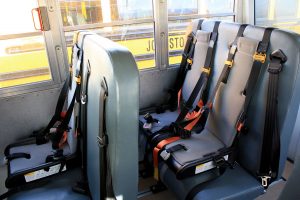Providing Safe Transportation To and From School
When it comes to driving a Johnston school bus, there’s a lot of preparation that goes into sitting behind the wheel.

A new Johnston STA bus driver practices securing a wheelchair to a series of clips and harnesses on the bus. All drivers must undergo at least 41 hours of behind-the-wheel training before driving independently.
Forty-one hours of preparation, in fact. Student Transportation of America (STA) is the transportation service provider for the Johnston Community School District. As part of their contract with the district, STA employs a safety manager who leads all drivers – new and current – through extensive training on all things school bus related.
Robin Witt is the safety manager in Johnston. She leads the classroom and behind-the-wheel training, including knowing the physical parts of the bus and how it operates, student management, and Department of Transportation (DOT) specifics. Witt said integration of new features, such as cameras, GPS, and the SafeStop mobile app contribute to an all-around better transportation experience for drivers and students.
“For many of our drivers, this is more than just a job,” Witt said. “They take their routes, safety, and the well-being of the students very seriously. Driving a bus means following the rules of road, but a big part of the job is student management. We really focus on these things throughout their new driver and continuing education training.”
Each Johnston/STA bus comes equipped with a number of features to enhance the safety for both drivers and students.
Cameras
There are four cameras on each bus. Software allows the office staff to review the tapes if there is an incident and the multiple-angle footage often helps to see the full picture of what is happening.
GPS
Between construction routes and new housing developments, drivers and STA staff have come to rely on their GPS trackers to assist in routing and accountability. In addition to navigation, it records if the bus door was opened and what safety features are turned on, such as the flashing lights, stop arm, and stop sign.
SafeStop Mobile Application
This fall, the district introduced the SafeStop mobile app, which allows families who have downloaded the app to see where the bus is en route to their stop. With the cold weather season in full swing, it’s a helpful way to get to the bus stop on time (five minutes early) and not stand outside for an excessive amount of time.

A number of Johnston/STA special education buses come with built-in five-point harnesses, seat belts, and booster seats to accommodate riders with a variety of needs. For even the smallest of students, these measures ensure a safe trip to and from school.
Specialty features
Buses that regularly transport special education students come equipped with additional safety gear, including seat belts, safety vests, integrated car seats, or booster seats with five-point harnesses. For some special education students, it is critical that their health devices not move around as they are transported.
Witt said drivers and bus associates with special education routes and students undergo more extensive training which includes how to properly secure wheelchairs, operate the lifts, and evacuate students secured in this equipment in case of emergency.
What’s next?
Within the next year, Witt said they would like to create a mentorship program for new drivers. She said the culture within the Johnston-STA office is coming together as the year rolls on.
“People – drivers, students and parents – are realizing the good things that are happening out there,” Witt said. “Our drivers are committed to practicing safety on every route, at every stop. At the end of the day, we all want a safe trip.”